Avoiding the Blister Blues
Good Detection and Communication Techniques
Critical to Avoiding Complaints
by David H. Pascoe, Marine Surveyor
Hull blistering is a problem that has been with us for a quarter-century. One might think that over a period of twenty-five years this problem would have long since been solved, and no longer be much of a problem for surveyors. Unfortunately, our research reveals that the blistering of boat bottoms continues to be a growing source of complaints and lawsuits against surveyors. It seems to be one of those pernicious problems that just won't go away. In fact, the number of lawsuits against surveyors has actually increased dramatically in the last several years.
One of the reasons for the increasing numbers of complaints is clearly the result of both yards and independent contractors having stepped up their efforts in marketing blister repair solutions. Blister repair has become a big business and repairers are roaming around boat yards looking for blistered boats, seeking repair work. That can mean that if the surveyor doesn't find the blisters on a hull, these people probably will.
- A Problem With a Solution
- The Genesis of Trouble
- Obligation to Inform Economic Impact
- The Working Environment
- How Blisters are Concealed
- Sighting
- Weepholes and Deposits
- Sounding
- Destructive Probing
- Lamination Problems
- Describing Blistering
- Use a Camera
- Reporting
- Interpretation
- Communications
- Keep Good Records
Contents
Despite the numerous studies, research reports
and magazine articles on the subject, there is not much
concordance on the cause and effect of blistering. Most
of the literature seems directed at repair solutions rather
than how to prevent blisters from occurring in the first
place.
The simple fact is that hull blistering is caused by the
use of inferior materials and shoddy layup. As Lee Dana,
former head of engineering at Bertram Yachts told the audience
at the annual conference of the National Association of
Marine Surveyors in 1985, hulls built with high quality
resins don't blister. If builders want to build hulls that
don't blister, all they have to do is "spend another
ten dollars per gallon for resin," he said
This fact is well known, but rarely considered by surveyors
or the boating public. If boat builders wish to build hulls
with inferior resins, then they, not surveyors, should be
the ones who pay the price with warranty complaints and
law suits. Unfortunately, most complaints and lawsuits against
surveyors occur with older vessels which are either out
of warranty or the builder is no longer in business. Moreover,
most warranties only warrant the first vessel owner, leaving
the next buyer in the lurch, which explains why the surveyor
ends up in a particularly vulnerable position.
The good news is that there are a number of things that
surveyors can do to protect themselves. And, if you're not
already doing them, this article offers some highly effective
methods for protecting yourself against problems that rightfully
belong to the boat builder.
The Genesis of Trouble
My review of nearly a dozen complaints against
surveyors shows that nearly all of them got into trouble
because they (1) failed to locate existing blisters, or
(2) failed to give adequate advice to the client. Most allege
that the surveyor either did not inform the client of the
presence of blisters at all, or that he merely mentioned
their existence, but downplayed their significance.
In at least three cases, the client maintained that blisters
got substantially worse shortly after the survey was conducted,
a claim which is dubious at best. In one case, a client
claimed that blisters appeared on an older vessel a year
after a survey revealed that there were no blisters, the
so-called "mystery blister syndrome." In another,
it was claimed that blisters appeared only a few months
later.
Frankly, it is hard to put much stock in the mystery blister
syndrome. Although its well known that blisters will change
their profile considerably as a result of changing environmental
conditions such as temperature, humidity and drying out
after being hauled for a period of time, I've yet to see
a case of deflated blisters that wasn't readily observable
under proper conditions. Nor have I heard of any documented
cases where blisters developed rapidly (The lone exception
to this was Hatteras yachts which was known at one time
to have used a grossly inferior gelcoat because they painted
their hulls). The minimum development time in new vessels
seems to be around three years but usually much longer.
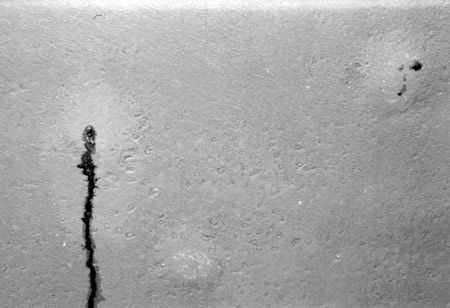
There are three blisters appearing in this photo of a boat bottom which is very clean and smooth. Two of them are easily revealed by the fluids that leaked out after the boat was sitting for many weeks. But the blister at lower center is barely visible. All of these blisters were highlighted by good artificial lighting used to take the photo.
Without that lighting, and absent the weeping, it would have been very difficult to locate these blisters. After wetting down with water, they became much easier to see. If the bottom were dirty, its not likely that they would have been located.
One way or another, unless they don't mind
footing the bill for what should be a boat builder's problem,
surveyors need to take some well defined steps to protect
themselves from becoming convenient targets for recovery
of repair costs.
Obligation to Inform
The failure to properly advise or inform a
client can certainly be construed as malfeasance or negligence.
This means that the surveyor is charged with the responsibility
of making every reasonable effort to determine the presence
of blisters, be they inflated or deflated, and advise the
client accordingly. This does not mean, however, that under
the definition of a survey, surveyors are charged with making
a technical analysis of cause and effect. It does mean that
they have duty to report on conditions that are discoverable
or apparent to any other surveyor or expert who would be
likely to find such conditions.
Economic Impact
Regardless of the prevailing wisdom of the effects of blisters, whether they cause structural damage or not, it is well known that blisters are likely to cause an economic loss to the client, for which the surveyor can be held liable in the event that he fails to detect and advise. Yet a client may exhibity no concern for the existence of blisters, nor be interested in repairing them. The problem usually arises when the client goes to sell the boat. The new buyer may demand that the your former client reduce his price by $6,000 to allow for blister repair. Or he may be approached by a hungry yard manager or repair outfit and given a litany of horrors on how blisters are destroying his boat. Either way, this is how a formerly unconcerned client can suddenly become a hostile adversary.
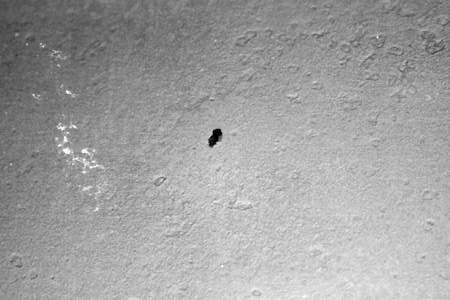
Without the dark weephole to announce its presence, this blister is not visible under ordinary conditions. It has very little raised contour and is only slightly revealed by a stong light played across it at a low angle. Yet tapping it with a coin clearly reveals the separation of the gelcoat by sound.
Many surveyors get in trouble because they
encounter conditions that inhibit their ability to perform
their work. For the most part, surveyors get so conditioned
to working under extremely poor conditions that they no
longer are even aware of how badly their work is hampered
by a poor work environment.
We should first understand that courts rarely award judgments
to plaintiffs for conditions that are entirely beyond the
control of the defendant. They award judgments simply because
the defendant failed to properly advise the client about
what he could, or could not do. It is not too much for the
client to expect the surveyor to advise him of the limitations
of his service, particularly when it involves dangerous
or costly conditions. Therefore, the principle to be applied
under all such limiting conditions is to make sure that
the client is properly advised of any factor that adversely
affects the surveyor's ability to perform his function as
the client expects him to do.
Secondly, surveyors run into trouble as a result of a failure
to fully and accurately inform the client of the full import
of any negative condition, whether by omission or misconstruction
of any material fact. An example would be to say that blisters
on a boat bottom are of no significance when, in fact, they
may cost thousands to repair.
Third, surveyors also fall victim to the failure to give timely advice. As we know so well, brokers are eager
to close the sale as rapidly as possible and clients often
close a sale long before the survey report is even
written. It is not enough to merely advise him of defects
or limitations only by means of the written report. Whenever
serious and costly defects are discovered, or the surveyor
is seriously hampered in performing his work, it is imperative
that the client be advised as soon as possible. Unless the
surveyor does this, the client may have a legitimate complaint
that he suffered a loss as a result of the failure to give
timely advice.
How Blisters are Concealed
I have yet to see a case of blistering that
could not be detected by nondestructive methods, which is
not to say that there aren't conditions that disguise them.
Two of the most common hindrances are heavy paint buildup
and dirty bottoms.
Once blistering occurs, the outer skin or gel coat becomes
stretched and will never fully return to its original contour.
The "hump" may be very slight, but if you are
looking for it, you will find it. But to do so, the bottom
needs to be clean and smooth. A bottom that is dirty and
rough is not capable of giving off enough reflected light
to show up the changes in contours so that the blister is
likely to be obscured. If the bottom is not cleaned, or
is extremely rough, the surveyor cannot do his job and therefore
he must make this situation clear to the client, verbally
and in writing.
A heavy buildup of paint that has a lot of flaking yields
a very rough surface that is ideal for hiding blisters.
Even so, this does not mean that if blisters exist they
cannot be found. It just means that the surveyor has to
look very close. Wet bottoms reflect more light and will
show up blisters much better than a dull, dry bottom. You
can visually sight the bottom immediately after it is pressure
washed to take best advantage of this. Since boats that
have been out of the water for a while are reported as most
likely to have deflated blisters, get a hose and wet the
bottom. If the bottom is clean, no matter how shallow they
are, the blisters will show up if you sight it carefully.
A third factor is the positioning of the vessel at the time
of the survey. If the vessel is sitting too close to the
ground, it becomes very difficult to get a good look at
it. Another problem is when boats are hauled out inside
of covered buildings where there is an inadequate light
source. When encountering these conditions, its time to
be extra cautious. One way or another, the surveyor has
to overcome these obstacles or risk the consequences.
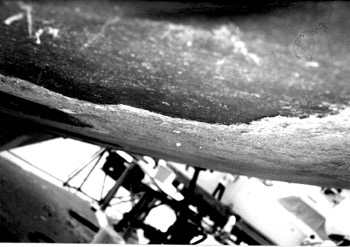
This is an example of severe ply separation. The peeled away ply here measures about 3 feet across. In this case the skin out mat was so dry that there was little bonding to the inner structural laminates. The whiteness clearly indicates how dry it is. This allowed the interface between the two plies to fill with water.
While this is an extreme example, incomplete bonding to lesser degrees is commonplace. To make matters worse, it was not detectable by sounding, although there was a bit of a warning sign in that the whole hull sounded somewhat "dead." These were not blisters but water filled ply separations that do not appear to have been initiated by osmotic pressure but rather enhanced by it. Scraping with a knife below the gelcoat easily revealed the dryness of the fibers.
Careful sighting is a must. To sight the bottom
in such a way as to best locate blisters, it is necessary
to view the hull from many angles. This is not difficult,
but it may mean a lot of duck-walking around so that one
can use the available light to best advantage. A casual
look at the bottom just won't do.
Weepholes and Deposits
Some gelcoats are so weak that they are unable
to sustain the buildup of pressure and the blisters rupture
either before, or after they reach a significant size. Under
these conditions, styrene fluids usually weep out of the
laminate, leaving a telltale stain or bubbling deposit as
shown in the nearby photos. The important point to bear
in mind here is that the breach in the gelcoat is also allowing
water to penetrate the laminate, so that blistering is likely
to be progressive. Since these are actually ruptured blisters,
these telltale signs should not be ignored but rather reported
as broken blisters that are just as significant as unbroken
blisters.
Sounding
Sounding a hull is an audible technique that requires a high degree of skill and finesse. We've seen surveyors attack hulls with a plastic hammer as though they were driving nails. That may turn up a severe delamination, but its not likely to reveal a small blister. Our experimentation with plastic hammers have determined that these are far from the best instruments to use to detect smaller flaws. For one thing, the impact surface is too wide. For another, plastic against plastic is not a very good combination for getting the best audible result. Blisters are most responsive to a small piece of metal, preferably steel, about the size of a silver dollar. Very light tapping with an instrument of this sort will do a much better job of audibly revealing differences in laminate thickness, particularly blisters.
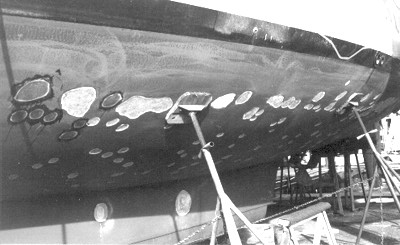
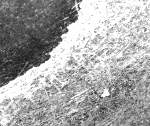
Notice on this hull how the blisters run along a band about one foot below the waterline. Also note how they appear in clusters lower down on the bottom, and that some areas between clusters are not affected. Examples like these prove once and for all that blistering is not merely a function of material, but also a matter of the quality of the layup.
On this boat, the areas of blistering are not random but area-specific and directly related to permeability of the laminate due to imperfections. Once again, the skin out mat was found to be poorly saturated. Lower photo contrasts the dry mat against the fully wetted out structural laminate.
Should the surveyor break open, probe or scrape
blisters? Certainly it's useful to determine whether the
underlying plastic has dissolved or whether there are substantial
ply separations. But doing this falls in the category of
destructive testing. Complaints have been made against surveyors
who have gone too far in doing this. it's best to get the
owner's permission before proceeding.
Because secondary bonding failures have been identified
with large blisters, the surveyor can take one of two approaches.
If he does not, or cannot engage in destructive testing,
he can simply warn the client of the possible implications.
However, if he breaks the surface at all, at that point
he needs to go all the way. Sliding a short, very thin blade
such as a cheap steak knife or pallet knife into the blister
and probing the circumference for ply separation will usually
do the trick. If you can continue to force the blade under
the skin out mat beyond the circumference of the blister,
there is definitely a bonding problem.
On the other hand, if you cannot force it, that does not
necessarily mean that there is not a secondary bonding problem.
It could not exist at one location but appear in others.
And since this cannot be done for all the blisters, this
test can only be used to confirm positive results.
Lamination Problems
Boats that display extreme numbers of, or
numerous and very large blisters may be suffering from more
than just water permeation through the surface coating.
My studies of hundreds of blistered boats reveals that many
boats that display very large blisters are also suffering
from secondary bonding failures. Bonding failures that result
in blisters usually occur between the gelcoat and skinout
mat, or the skinout mat and the first layer of structural
fabric, usually roving. The failure to bond can be due to
environmental conditions (temperature and humidity), contamination,
or excessive delay in the layup process. Whatever the cause,
the result is an incomplete bond that provides and ideal
environment for very large blisters to develop. When a vessel
has numerous large blisters, secondary bonding problems
should be suspect. For a more complete discussion of bonding
failures, see article titled The Wonderful World of Blistering on this site.
If the bonding of laminate is weak, you may be able to separate
the skinout mat for very long distances, in which case you've
got a serious bonding problem that no commonly accepted
method of blister repair will solve. To remedy the situation,
all of the loose laminate will have to be stripped off.
Describing Blistering
It is important that the general parameters
of blistering be adequately described. One way to describe
blistering is to again use a grid and literally measure
and count the number of blisters. Using a tic-tac-toe grid
of one foot squares will yield nine squares that make it
quite easy to count the number of blisters per square foot.
Since blisters do not always show up evenly over the bottom
surface , but can appear in clusters or bands, it
is probably best not to attempt to give an exact count,
but rather to determine the density and state the condition
in terms of maximum density, but not attempt to indicate
specific sizes or locations. Attempting to describe
the size of the area and specific density can be difficult
and dangerous. This way, if the blistering spreads rapidly
to other areas , the surveyor won't get caught short.
In other words, it's better to overstate than understate.
Use a Camera
If you're not carrying a camera and using
it, you're missing out on a better insurance policy that
you could ever purchase. Good photographs will stop most
misinformed complaints dead in their tracks. Using a piece
of chalk, write the boat name and date on the area to be
photographed, and then snap a couple shots from a variety
of angles.
If you are not expert at using a camera, then you need to
practice until you become so. Bad photos won't help you
much. Take multiple shots using different angles and lighting
and learn which techniques work best. Use a flash in virtually
all conditions except direct sunlight, especially when a
subject is half-in, half-out of direct sun. Make sure your
flash is illuminating the subject. With good quality modern
cameras, auto exposures will work perfectly; there's no
need to play with timing and f-stops anymore. But I would
suggest avoiding using autofocus which does not always work
well. Get in the habit of focusing manually.
Photos won't do you any good when, several years later you
can't find them. Storing them in a file is not a good idea
because they often fall out and get lost. I store photos
and negatives in the lab's original envelope and then file
them chronologically in shoe boxes, which are then labeled
with the year. This makes for a very convenient method of
locating them quickly.
Reporting
One good approach is to develop a more or
less standard statement dealing with the issues of blisters
for every report on fiberglass boats, one which is modified
to fit individual circumstances. A good statement is one
which first informs the client that reinforced plastics
are known to be unstable. It should state that the surveyor
is not able to determine the nature of the plastics and
reinforcements of which the hull is made, and therefore
he cannot guarantee the stability or the performance of
the laminate.
To make assumptions about a laminate is to take risks that
we ought not take. To look at a hull and say, "Ah,
fiberglass," is making an assumption that is not based
on anything we really know. In truth, we have no idea of
what that hull is made of, and could be an endless array
of materials. Nor can we give any assurance of the quality
of those materials.
It should be clearly stated that warranties of the hull
are provided by the builder only, and that if there are
any questions about existing warranties, the manufacturer
should be consulted. It should go on to state that the surveyor
has made every effort to determine the presence of blisters
short of destructive testing, and that blisters were, or
were not found. This, however, does not mean that blisters
won't develop at a later date. It should be made clear that
changing conditions may result in the sudden appearance
of blisters where previously there were none. Finally, one
should point out that latent blisters, or blisters in the
very early stages of formation, or blisters which are depressurized
and deflated may also exist, and which are not detectable
by any means available to the surveyor.
When sighting the bottom, be alert for evidence of prior
blister repairs which are often done shortly before the
boat is sold. The reason for this is that the surveyor has
no idea of whether a proper repair has been made. Often
as not, and owner has just ground out the blister and filled
the void with epoxy. In this case the blistering is very
likely to continue and may come back to haunt the surveyor.
The best way to protect yourself is to report all evidence
of prior repairs and disclaim any guarantee that the blistering
will not continue.
Interpretation
Unless a surveyor is going to engage in some
serious destructive testing and analysis, he really doesn't
have any way of knowing what the presence of blisters means.
And for clients, the significance of blisters is an entirely
subjective judgment. We've seen sailboat buyers go ballistic
at the mere mention of blisters, while others may not care
in the least.
When clients question the surveyor about the significance
of blisters, the wise surveyor is one who knows that he
doesn't know, and resists the temptation to speak when he
shouldn't. In my view, the best approach is to advise the
client that only a technical analysis based on destructive
testing can answer that question, and that this is not included
in the survey service. It is best to advise the client that
a prepurchase survey is a condition and not an engineering
analysis. If you wish to get involved in destructive testing,
separate this service from the survey and set it up as a
consulting service. Start a separate file and issue a separate
report and billing, even if you end up doing it generally
at the same time. This will help protect the surveyor from
claims of a negligent survey.
Communications
Learning to communicate fully and effectively
with the client is a very good form of insurance. But there
is a fine line to be walked between communicating facts
and engaging in idle speculation. Engaging in speculative
conversation may lead the surveyor to say things he didn't
intend to say. On the other hand, several complainants told
us that they were particularly miffed by a surveyor's lack
of communication. Doctors are notorious for this and we
all know what it's like to visit a doctor with lock jaw.
We feel cheated because our desire for information wasn't
fulfilled. Our opinion of the doctor drops dramatically.
it's very easy for the surveyor to fall into the same trap
because his work is strenuous and he's usually exhausted
by the time he's finished, thereby diminishing the effectiveness
of his communication.
Obviously, the best way to communicate a blistering problem
is to physically show the client what is there. Even if
he doesn't want to, make him look at it with his own eyes.
Make it standard operating procedure to show him the entire
hull bottom. There is nothing like direct client involvement
in a problem to head off disputes.
Remember that a client who seems unconcerned about blisters
at the time he is purchasing a boat that has them, may develop
other ideas later on. If he decides to sell a short time
later, and is faced with a $6,000 repair bill, it's pretty
obvious what is likely to happen if the surveyor hasn't
adequately covered himself.
Keep Good Records
Any time a problem case ends up going to litigation,
nearly all experienced surveyors will tell you that they
often end up falling victim to a universal shortcoming -
the failure to keep good notes. Litigation usually occurs
years after the surveyor's initial involvement, and long
after his memory has faded. Thus, when a subpoena is shoved
under his nose, he retrieves his file only to find that
there's not much there to help him.
Because hull blistering is such a universal problem, any
surveyor who has been in the business long enough is eventually
going to be hit with some sort of complaint. Every one has
bad days and makes mistakes, often as a result of circumstances
beyond the surveyors control, such as being rushed or hindered
by bad weather. Sooner or later, the surveyor will find
himself caught short.
A marine surveyor can get no better liability insurance
policy than by training himself to keep good notes. Of course
it's very difficult to do that on the job when there are
so many distractions and difficulties. He can't take good
notes while standing in the rain or on the deck of a bouncing
boat. But he can train himself at every instance to review
his work once back at the office, and to fill in or expand
on those notes he did take while on the job. This is why
photography can be so useful. It only takes moments to snap
a picture of a condition that might take ten minutes to
attempt to write up on paper or, worse yet, can't be written
up at all because of adverse conditions.
We should bear in mind how lame our excuses are likely to
sound when sitting in front of a jury.
Related Article: The Wonderful World of Hull Blistering
First posted 5/19/97 at David Pascoe's site: www.yachtsurvey.com.
Page design changed for this site.Last reviewed 11/28/98
Professional Marine Surveys
- Hull Design Defects - Part I
- Hull Design Defects - Part II
- Surveying Boats With Molded Integral Grid Systems
- Surveying Wood Hulls
- Avoiding the Blister Blues
- Sinking of EL TORO II
- Storm Damaged Boats
- Insurance Surveys and Reports
Power Boat Books
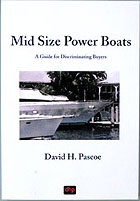 Mid Size Power Boats
Mid Size Power Boats A Guide for Discriminating Buyers
Focuses exclusively cruiser class generally 30-55 feet
With discussions on the pros and cons of each type: Expresses, trawlers, motor yachts, multi purpose types, sportfishermen and sedan cruisers.
Selecting and Evaluating New and Used Boats
Dedicated for offshore outboard boats
A hard and realistic look at the marine market place and delves into issues of boat quality and durability that most other marine writers are unwilling to touch.
2nd Edition
The Art of Pre-Purchase Survey The very first of its kind, this book provides the essentials that every novice needs to know, as well as a wealth of esoteric details.
Pleasure crafts investigations to court testimony The first and only book of its kind on the subject of investigating pleasure craft casualties and other issues.






